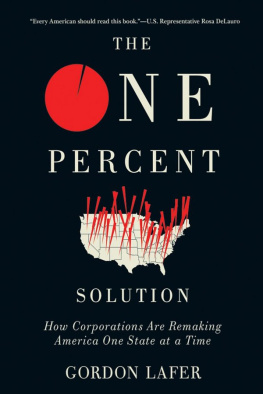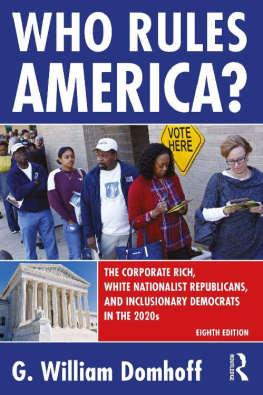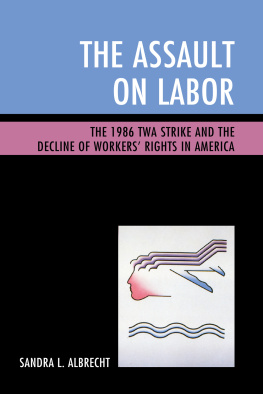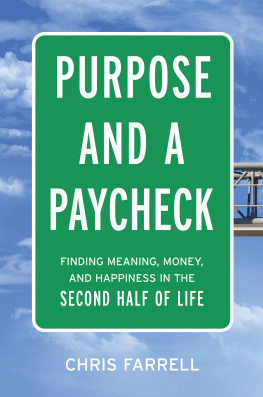For Merav
And in memory of Talia Ranit Goldenberg
Acknowledgments
This book is the product of five years of research and writing, preparing legislative testimony, briefing lawmakers, and trying to make sense of the flood of corporate-backed legislation that hit the country starting in early 2011. As long-dormant policies like right-to-work were suddenly revived and radical new policies gained currency, economists in a wide range of think tanks and universities scrambled to assess the claims put forth by corporate lobbyists. Every chapter of this book relies, in part, on the expertise that others have brought to bear on these issues. I am particularly indebted to the work of Sylvia Allegretto, Dean Baker, Dale Belman, Donald Cohen, Lee Cokorinos, Laura Dresser, Peter Fisher, Matt Gardner, Amy Hanauer, Ken Jacobs, Jeff Keefe, Mark Levinson, David Madland, Peter Philips, Steven Pitts, and Joel Rogers.
Some of the most important work available to scholars of this period has been done by investigative journalists. Like everyone in this field, I owe a debt to Jane Mayer, Lee Fang, and the Center for Media and Democracy for their pathbreaking work in bringing to light the operations of ALEC and the Koch network.
I hit the academic jackpot when Adolph Reed agreed to be my PhD adviser many years ago, and he has remained a guiding light throughout this project. I have also been fortunate to benefit from the work and wisdom of academic colleagues in Oregon and beyond, including Eve Weinbaum, Janice Fine, Frances Fox Piven, Corey Robin, Michael Yates, John Logan, Stephanie Luce, Ruth Milk-man, Gerry Berk, Margaret Hallock, Dan Tichenor, Joe Lowndes, Priscilla Yamin, Marty Wolfson, Glen Perusek, Rosemary Batt, and Tamara Kay.
Alex Molnar, Bob Peterson, and Barbara Miner were particularly generous with their time and helpful in enabling me to understand the extensive scholarship and long history of education reform.
Above all I am indebted to the Economic Policy Institute, whose support made the research for this book possible. I have relied on EPIs work for decades, but during the research and writing of this book, I benefited much more directly from conversation, criticism, and collaboration with the institutes staff. Through EPI, I published a series of reports on topics included in this book, and the book would not have been written without the institutes support for those projects. Im particularly grateful to Larry Mishel, Ross Eisenbrey, Heidi Shierholz, Elise Gould, Josh Bivens, Doug Hall, Alyssa Davis, Liz Rose, Mary Gable, and Lora Engdahl for their contributions to that work.
I have relied my entire adult life on a set of friends whose comradeship has sustained me through this project as with all that came before, including Hillary Kunins, Michael Berkowitz, Joel Westheimer, Barbara Leckie, Eric Wittstein, Jane Wittstein, Eve Weinbaum, Delia Rickard, Reuven Kleinman, Jonathan Stein, Pete Hallward, Greg Grandin, Derek Spitz, Andy Spitz, Noah Efron, Alisa Klein, Photini Sinnis, George Bourozikas, Rachelle Abrahami, and Artie Farkas.
Two peopleboth friends and scholarsmade particularly important contributions to this project. Janice Fine read early drafts of the manuscript and provided generous and invaluable guidance. Jonathan Stein reviewed the entire manuscript and provided critical editing. Both of them have made the book much better than it otherwise would have been.
The entire book would not have been possible without the work of a superb team of research assistants, including Jennifer Smith, Brian Ott, Camila Alvarez, Martha Camargo, Arthur Phillips, and Simon Davis-Cohen. Above all, I thank Debbie Levy, the most talented researcher I have ever worked with.
At the University of Oregon, I am grateful for the support of a remarkable set of colleagues at the Labor Education and Research Center, including Bob Bussel, Barbara Byrd, Lynn Feekin, Sherman Henry, Leola Jewett, Sarah Laslett, Deb Mailander, Helen Moss, Teri Mellor, Mary Page, Raahi Reddy, Leigh Roberts, Nikki Rudiger, Jennifer Smith, and Marcus Widenor.
At Cornell University Press, Fran Bensons encouragement and guidance were instrumental at every step of the process.
During the course of writing this book, my family suffered several deaths, including those of my father, my mother-in-law, and my niece Talia, to whose memory this book is dedicated. There is nothing good to say about those deaths, but they have heightened my appreciation and gratitude for my mother and sisters and for my extended family here in Oregon.
I am grateful above all for Rachel Kirtner. She is my first and most important intellectual partner, who not only has read and improved on every part of this book but has been my constant companion in making sense of American politics as theyve unfolded over the past decade. Her own leadership in the battle for economic justice is a constant source of inspiration: every day that I have spent talking and typing, she has been on the front lines fighting to protect students right to a decent education and teachers right to respect on the job. Above all, Im grateful that at the end of every battle, we get to come back to the home we have built together.
This book is dedicated to my daughter Merav, who lights up my life every day. At ten, she already has a big heart and a keen sense of justice and knows how to stand up for herself and her friends. I cant wait to see the rest of what she does.
Introduction
A CORPORATE POLITICAL AGENDA FOR THE TWENTY-FIRST CENTURY
In January 2015, Tennessees Republican governor, Bill Haslam, unveiled a proposal to expand his states Medicaid program to provide health insurance to two hundred thousand low-income residents. At the time, Haslam was at the peak of his power: he had just won reelection with 70 percent of the vote and had been named to head the Republican Governors Association. Haslam insisted that his plan was not Obamacare; indeed, he had gained concessions from the Obama administration allowing him to write conservative requirements into the program. His Republican colleagueswho controlled both houses of the legislaturesupported his proposal, based partly on polling showing widespread voter approval. And yet none of this was enough.
An advocacy group funded by the billionaire Koch brothers, Americans for Prosperity (AFP), sent field organizers into the state, ran weeks of advertising, and staged demonstrations insisting that any Medicaid expansion whatsoever amounted to a vote for Obamacare. Republican caucus chair Glen Casada termed AFPs campaign politics of intimidation. But it worked; the governors bill
The Tennessee experience raises important questions about American politics and the forces that shape Americans economic lives. How could an outside advocacy group overturn the will of elected officials and their constituents? What led a corporate-backed group to undermine its Republican allies? Why would the Koch brothers, whose primary interests are in the oil industry, care enough about Medicaid to bankroll this type of campaign? And finally, if corporate lobbies have the power to do what they did in Tennessee, what else could they do? In what other ways might they be trying to rewrite the rules that govern our economy?
In answering these questions, this book aims to show how Americas most powerful corporate lobbies are working to remake the countrys economy in ways that will affect all Americans profoundlyand yet are largely invisible to most of us. Understanding these forces legislative agenda is essential to comprehending Americas current political and economic trajectory. Because this agenda has been enacted in state legislatures rather than the U.S. Congress, it is state-level initiatives that form the subject of this book.
The United States is an economy in decline, with an increasing number of Americans unable to support their families at a minimally decent standard of living. In just three years, the post-2008 Great Recession erased two decades of growth in average household income. But the larger concern is a longer-term trend: the dismantling of the New Deal policies that created a booming middle class for several decades in the mid-twentieth century. In the new economy, declinegradual but relentlesshas become the new normal for an increasing share of the country.
Next page







